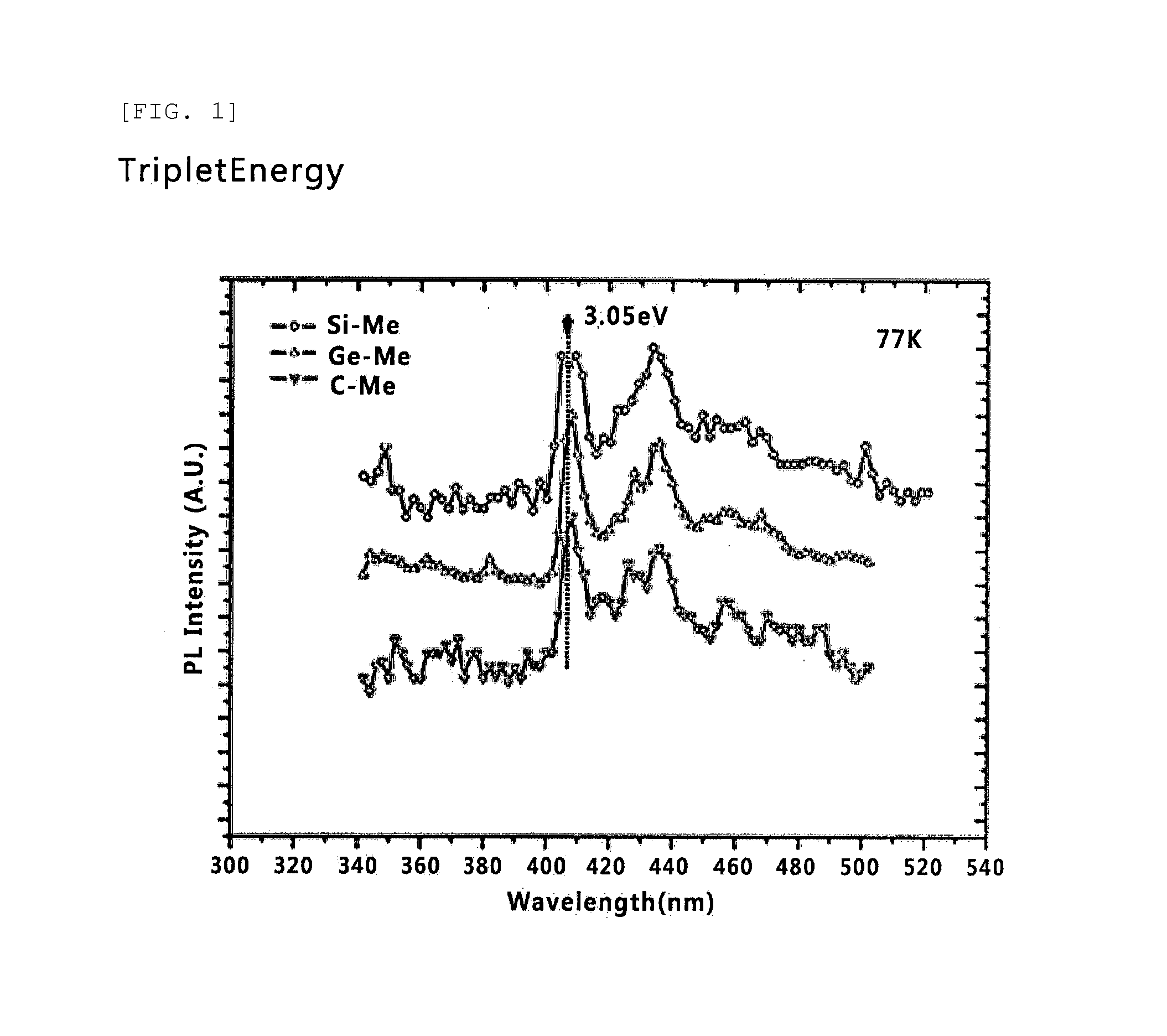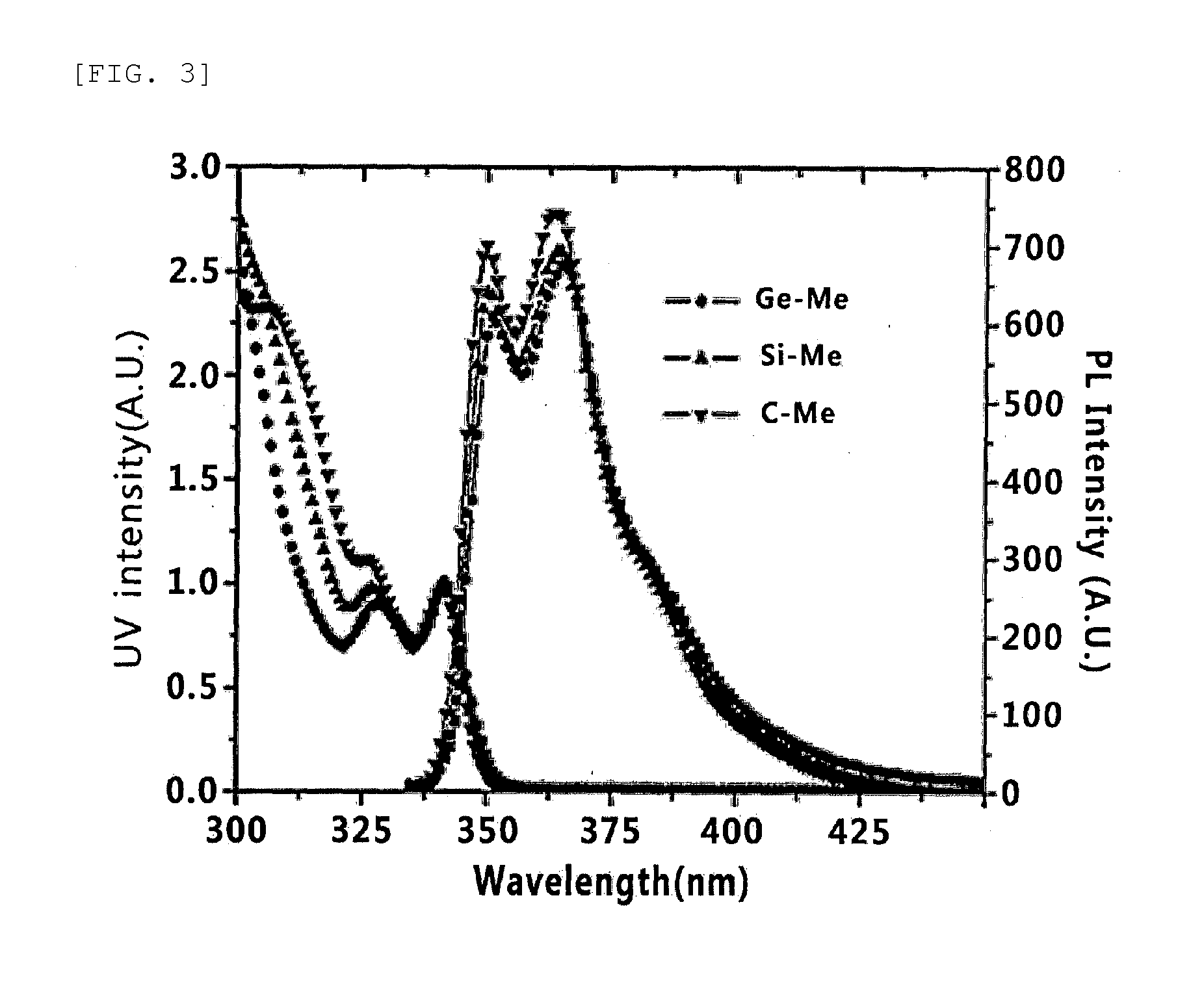Host Material for Blue Phosphor, and Organic Thin Film and Organic Light-Emitting Device Including Same
- Summary
- Abstract
- Description
- Claims
- Application Information
AI Technical Summary
Benefits of technology
Problems solved by technology
Method used
Image
Examples
example 2
Manufacturing of Ge-Me
[0086]Through Reaction Equation 2, the host material (Ge-Me) in which the three carbazole compounds were bonded around the central atom (M) Ge and the methyl group (Me) as the alkyl group was substituted in carbazole was manufactured. Specifically, manufacturing of the host material was as follows.
[0087]1. After Mg was activated and put into 30 ml of the THF solution at 0° C., bromobenzene (100 g) was put thereinto, and 70 ml of the THF solution was slowly further put. In addition, after 3 hours, GeCl4 (27.07 g) was slowly put at 0° C., and MeLi (5.53 g) was put while being maintained 0° C. for 1 hour, and agitated at normal temperature. After the reaction mixture was cooled, water was added, extraction was performed by methylene chloride, and the compound (Ge(Ph)3Me) was then separated by the column using the hexane:methylene chloride (1:1 volume ratio) mixture as the eluent solution.
[0088]2. After 5 g of Ge(Ph)3Me was dissolved in the CHCl3 solvent, Br2 (12.2...
example 3
Manufacturing of C-Me
[0091]Through Reaction Equation 3, the host material (C-Me) in which the three carbazole compounds were bonded around the central atom (M) C and the methyl group (Me) as the alkyl group was substituted in carbazole was manufactured. Specifically, manufacturing of the host material was as follows.
[0092]1. After 3 g of C(Ph)3Me was dissolved in the CHCl3 solvent, Br2 (3.99 g) was put thereinto and agitated at normal temperature. After the reaction mixture was cooled, water was added, extraction was performed by methylene chloride, and the target compound (C-compound in which three Br-benzenes were bonded) was then separated by the column using the hexane:methylene chloride (5:1 volume ratio) mixture as the eluent solution.
[0093]2. After carbazole (3.60 g) in which the methyl group (Me) was substituted was dissolved in xylene, the C-compound (2 g) was put thereinto, and K2CO3 (2.74 g) and CuI (0.15 g) were put and then agitated at 210° C. After the reaction mixture...
example 4
Manufacturing of Si—Pr
[0097]Manufacturing was performed by the same method as Example 1, but the propyl group was substituted in carbazole by using chloropropane instead of chloromethane (yield 47%). The final product was confirmed through 1H-NMR analysis.
[0098]Specifically, the host material according to the present Example 4 has the structure where M is Si, n is 3, R1 is represented by Chemical Formula 5, and R2 is the methyl group in Chemical Formula 1 [(R1)n-M-(R2)4-n].
PUM
 Login to View More
Login to View More Abstract
Description
Claims
Application Information
 Login to View More
Login to View More - R&D
- Intellectual Property
- Life Sciences
- Materials
- Tech Scout
- Unparalleled Data Quality
- Higher Quality Content
- 60% Fewer Hallucinations
Browse by: Latest US Patents, China's latest patents, Technical Efficacy Thesaurus, Application Domain, Technology Topic, Popular Technical Reports.
© 2025 PatSnap. All rights reserved.Legal|Privacy policy|Modern Slavery Act Transparency Statement|Sitemap|About US| Contact US: help@patsnap.com



